Memories of an afternoon
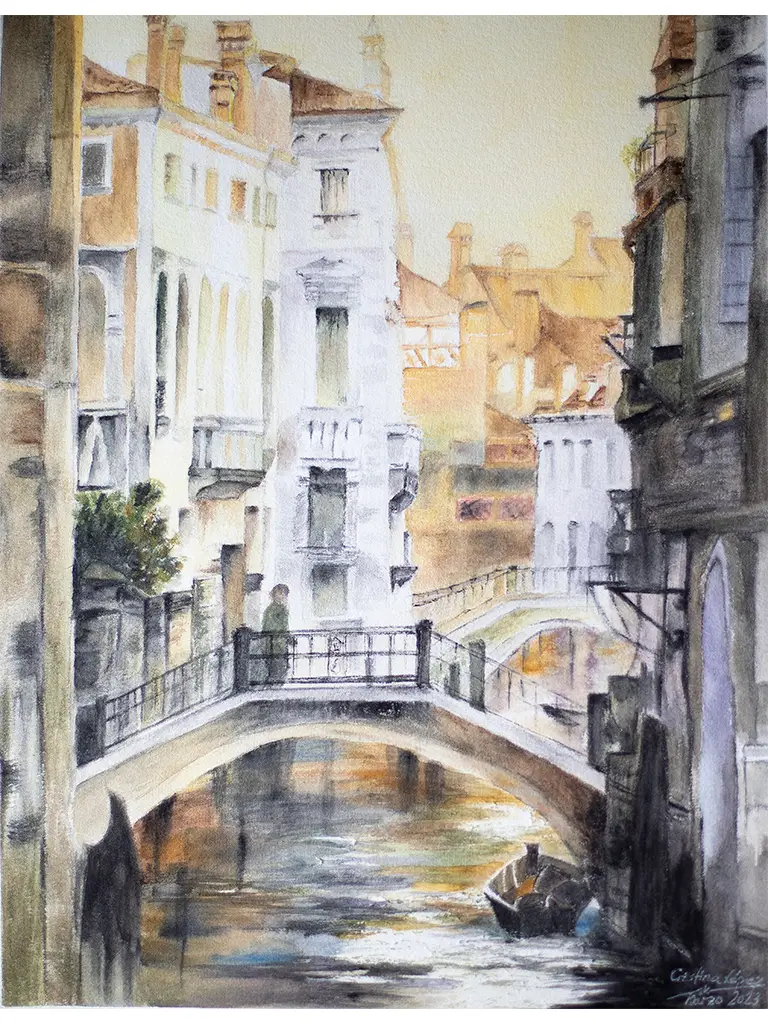
This watercolour painting portrays a European landscape where the river becomes the central thread of the scene, meandering calmly between vegetation-covered banks, small stone houses, and open skies that seem to breathe. The boats float still, moored or drifting, as if resting after a long journey. Some are empty, others barely outline the silhouette of an oarsman, hinting at a story escaping over the horizon.
The watercolour technique allows the water to paint the water: superimposed transparencies, soft reflections, blurred skies in shades of blue, grey and gold. The landscape is not contained, but suggested; there is more emotion than precision. The humidity of the river, the silence of the air, the patina of time on the facades… everything can be guessed in each brushstroke.
Inspired by river scenes from central and northern Europe, this painting seeks to capture not just a place, but a feeling: the melancholic stillness of riverside villages, where life moves to the slow rhythm of the water. In the background, perhaps there is a church or a mill, barely hinted at, as if emerging from an ancient memory.
It is a painting that does not shout, but whispers. A tribute to the quiet beauty of the everyday and the inevitable flow of time.
Memories of Japan
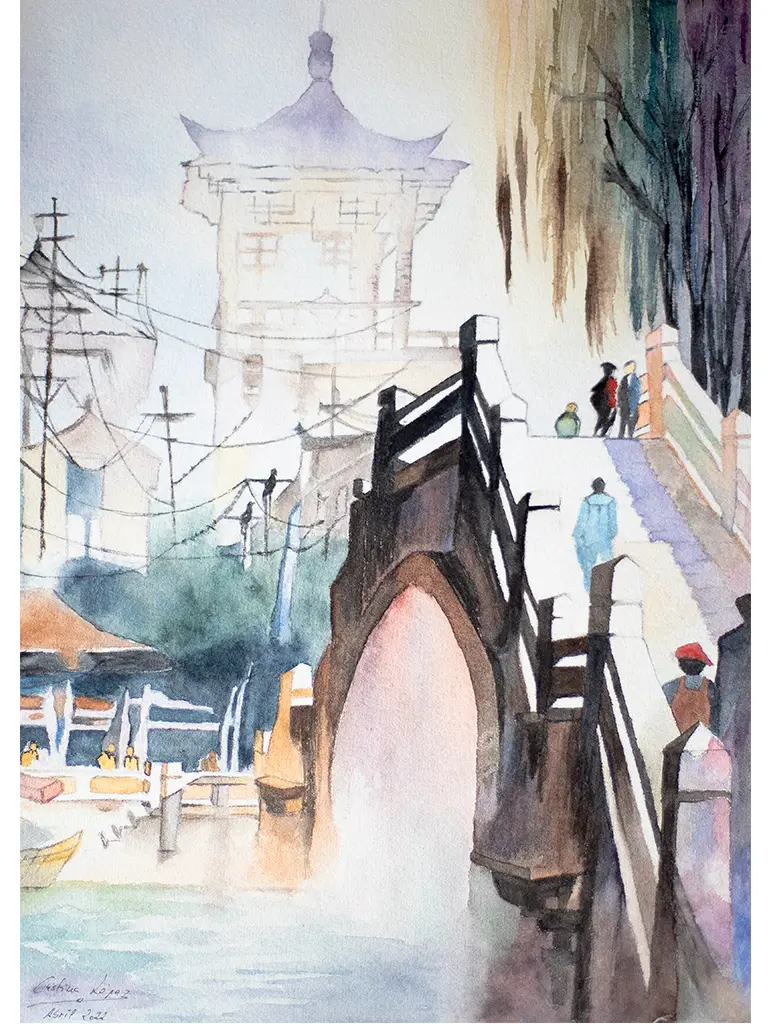
This landscape, painted in colour watercolour, is inspired by the traditional aesthetics of China and Japan, where nature is not only scenery, but spirit. The scene shows a tranquil river flowing through the paper as if it were flowing in a dream. An arched bridge connects the two banks, and on it walk small figures in traditional dress: kimonos or hanfu, serene faces, slow steps. In the background, almost as if emerging from the mist, the curved roof of a temple is insinuated, silently guarding the history of the place.
The watercolour technique has been worked with softness and breath. The brushstrokes are loose but meditated, evoking oriental landscape painting (shanshui) where the important thing is not fidelity to detail, but the balance between full and empty, between what is shown and what is suggested. The water, the silent protagonist, reflects the sky with barely defined spots, while the colours – earthy, soft greens, diluted blues – accompany the calm of the whole.
This drawing is not just an image, but an invitation to meditation. Like the old painted scrolls that were unrolled little by little, this landscape proposes a slow journey, where each element has its place, its weight, its pause.
It is a tribute to the ephemeral, to harmony, and to the beauty that dwells in the simple.
The eye of the horse
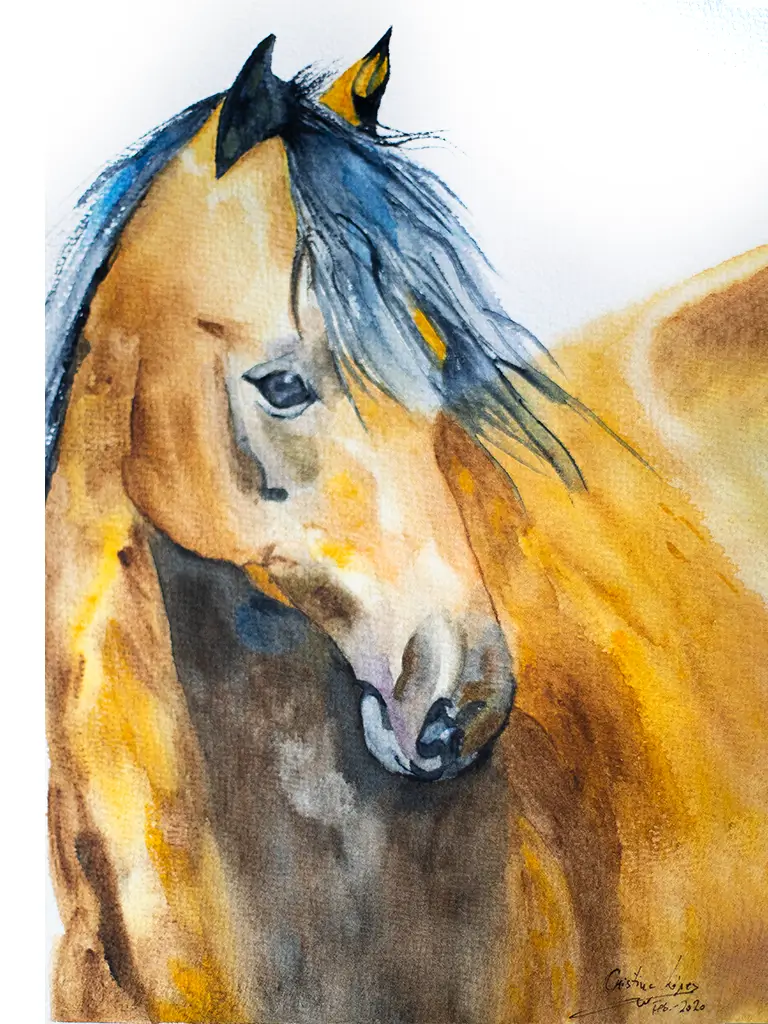
This portrait focuses on the head of a horse, captured in watercolour with a gaze that balances strength with stillness. The choice of watercolour is not accidental: its fluidity allows us to pay homage to the nobility of the animal without enclosing it in rigid lines. The water carries the pigment as the wind caresses the mane – freely, with rhythm, with respect.
Each stroke seeks to suggest rather than define. The soft shadows on the muzzle, the sparkle in the eye, the tufts of hair that blend into the background… everything is worked from transparency, allowing the white of the paper to breathe and give life. It is not a strictly realistic representation, but a presence: that instant when the horse turns its head slightly, hears something in the distance, and everything stops.
This drawing is an invitation to see beyond the form: to connect with the quiet dignity of the animal, with its ancestral memory, its contained power. Because in the silence of its gaze there is something that reminds us of who we were when we still lived close to the land and the animals.
Hummingbird on flower
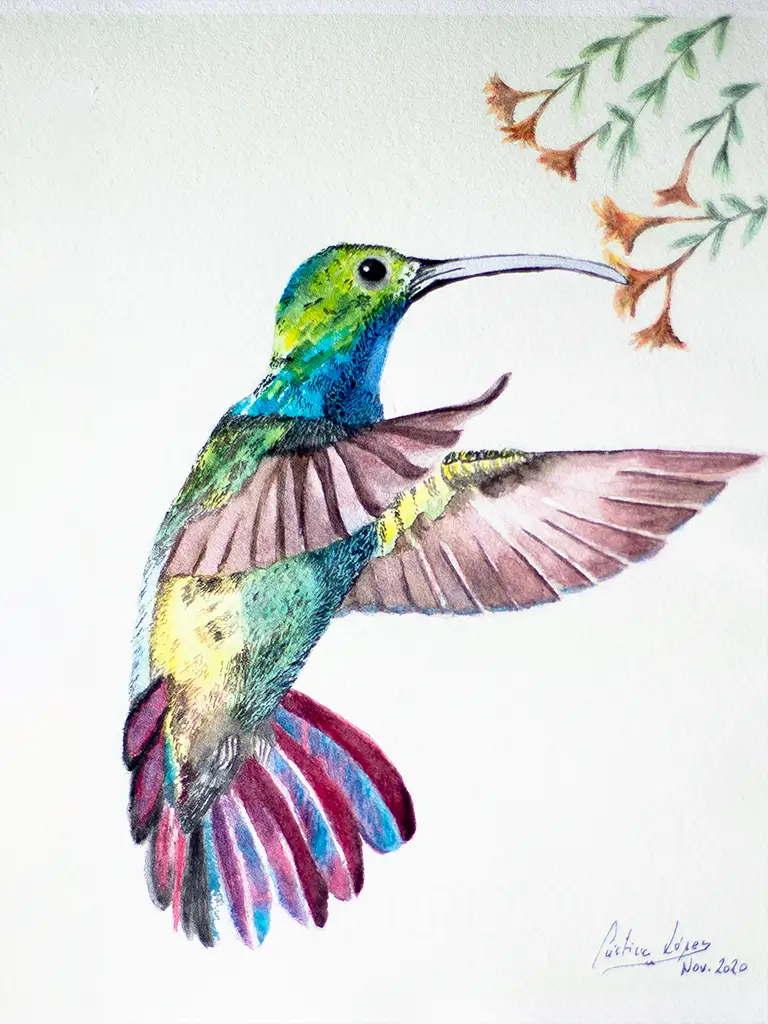
This small drawing captures a fleeting moment: a hummingbird stopped in mid-flight, its beak immersed in a flower. The work is executed in watercolour, ink and coloured marker, a combination that combines the ethereal with the precise. The watercolour brings transparency and movement, evoking the lightness of the air and the speed of fluttering wings. The ink, on the other hand, fixes the structure and gives character to the outline, while the felt-tip pen introduces vibrant, almost electric touches to the feathers and the flower.
Despite its small size, the drawing is full of energy. The hummingbird, a symbol of the ephemeral and the sacred in many cultures, represents here that almost invisible moment that passes before our eyes without our noticing. The gesture of approaching a flower, an everyday occurrence in nature, becomes an almost ceremonial act.
Each stroke was designed so as not to break the delicacy of the moment. The lightness of the water, the speed of the colour, the decisiveness of a line: everything converges to construct not only an image, but a pause.
Because sometimes the smallest thing contains the most intense thing.
Unknown II

This work portrays a young woman wrapped in a white shirt, a simple garment that nevertheless becomes the perfect vehicle for exploring light, transparency and the intimacy of the instant. The technique combines soft pastels and coloured pencil, a mixture that allows for both precise strokes and free gesture, creating a balance between control and spontaneity.
The pastels provide a velvety, almost floating texture that adheres delicately to the paper. The skin tones build layer by layer, revealing the pinks, ochres and lilacs that lie beneath the surface. Coloured pencil is used to accentuate the subtle contours, give definition to the eye and suggest the folds of the shirt, without harshening the overall softness of the drawing.
What lies behind this portrait is not just a female figure, but a restrained atmosphere. She does not look directly, she does not pose, she simply is. The white shirt is not just clothing, it is a symbol of vulnerability, of emotional cleansing, of an intimate moment in which the person is shown without armour.
More than a figure study, this drawing seeks to capture a suspended emotion, as if time has stopped for a second before something changes.
Unknown I
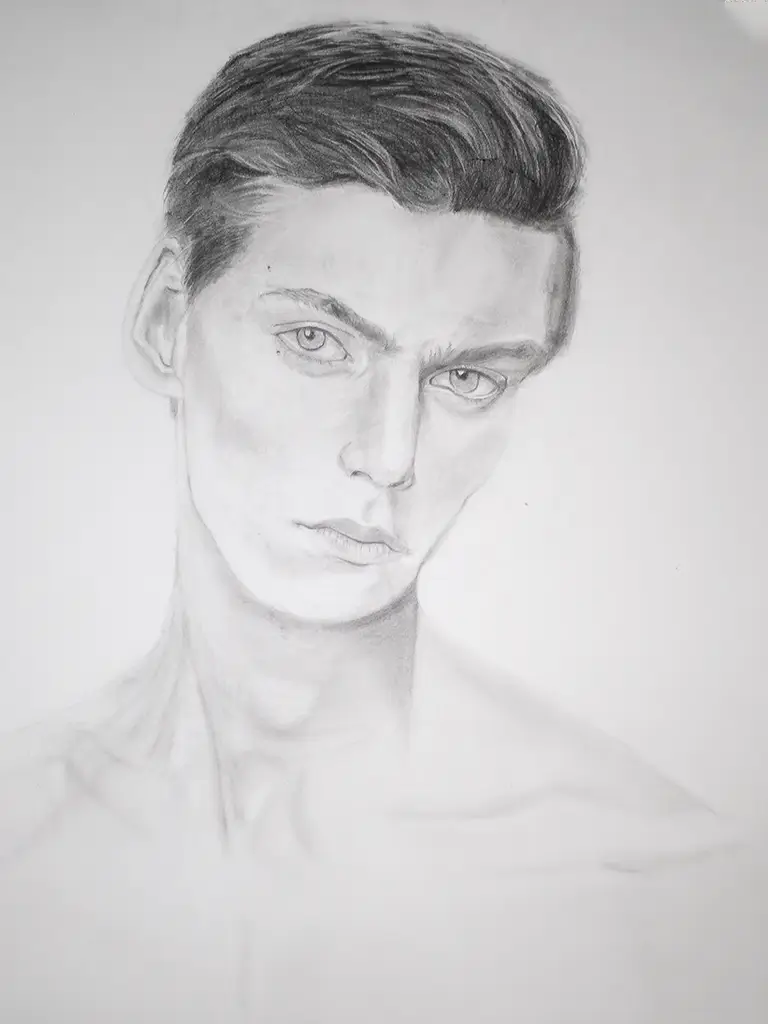
This drawing, made with charcoal on paper, captures the face of a young man whose expression is a mixture of strength and softness. Charcoal, with its ability to create intense contrasts and emotionally charged strokes, allows us to explore both the texture of the skin and the depth of the gaze. Unlike graphite, charcoal does not seek surgical precision, but rather an atmosphere, a feeling that breathes between line and shadow.
The process began with loose, gestural strokes, letting the face emerge little by little from the white void. The technique plays with the ephemeral: smudges, blurring with the fingers, lines that are almost completely erased and others that cling to the paper. Each layer is a decision between what is revealed and what is insinuated.
The figure depicted, with subtly effeminate features, does not respond to a specific ideal, but seeks to question it. What defines masculinity? Where does femininity begin? This face inhabits that in-between space, that terrain where labels are diluted. There is no fixed narrative; only a silent presence that invites us to look without prejudice.
Even the imperfections—accidental smears, fingerprints caught in the medium—are part of the story. They ground the portrait in reality, reminding us that this is not a polished icon, but a human being, captured in a moment of becoming. The drawing resists conclusion. It asks questions rather than offering answers, and in doing so, becomes a mirror for the viewer.
It is not just a portrait. It is an exploration of identity, of presence, of the fragile line between being seen and being understood.
Study of pastel lemons
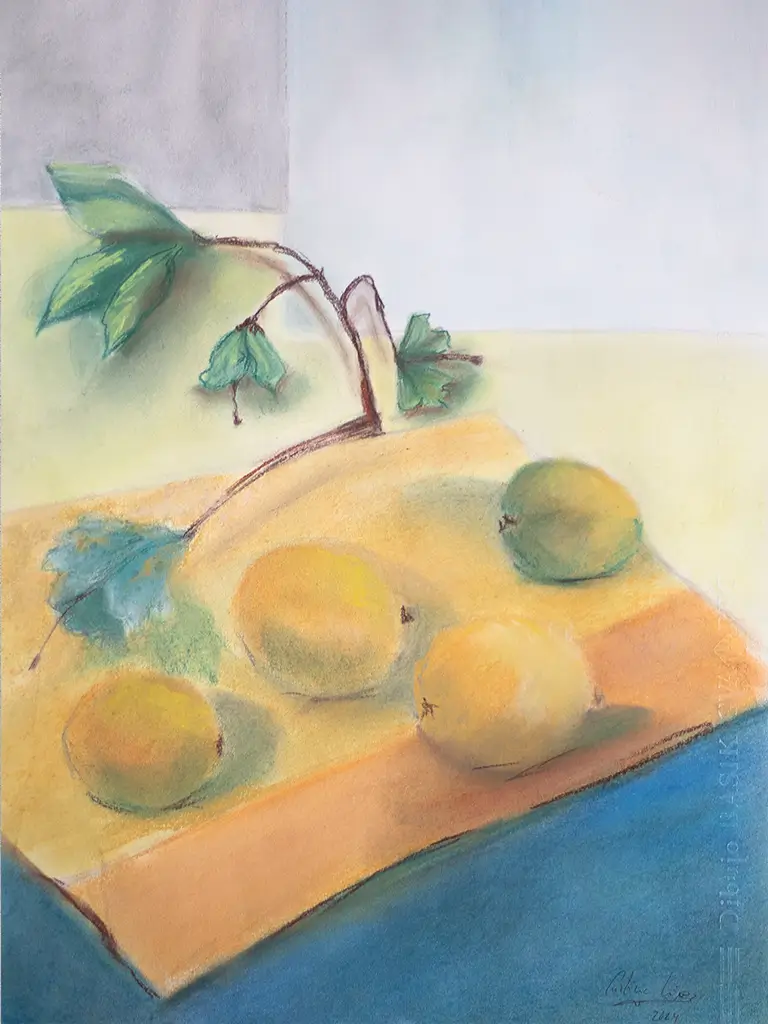
This pastel still life of lemons is a vibrant, tactile study of light caught in the everyday. The lemons, deep yellow almost amber in their sunniest areas, rest on a crumpled white cloth, with soft shadows melting into shades of lavender, ochre and olive green. The background is diffuse, barely suggested with warm tones and broad brushstrokes, making the fruits seem to float within an atmosphere suspended between realism and evocation.
The process was deeply physical. Working with pastels demanded direct, almost intimate contact with the paper. Each layer of colour was applied with the fingers, blurring the pigments to mimic the slightly porous texture of lemon peel. The artist experimented with overlapping colours – mixing canary yellow with soft greens and oranges – to suggest the hues that light cast on the rough surface. The composition developed organically, without sketching, allowing the objects to ‘appear’ as the hand felt them.
The inspiration behind the work was the desire to celebrate the commonplace. Not as something vulgar, but as something profoundly beautiful in its honesty. The lemons, bought from a street stall one spring afternoon, had small imperfections: spots, indentations, scars. Instead of hiding them, the artist exalted them. For there – in what is neither symmetrical nor polished – lies what is truly human. The use of pastel was not accidental: its chromatic richness and malleability were ideal for capturing not only the colour, but also the soul of these lemons, which seem to glow from within, as if they contained light.
Study of lemons in charcoal
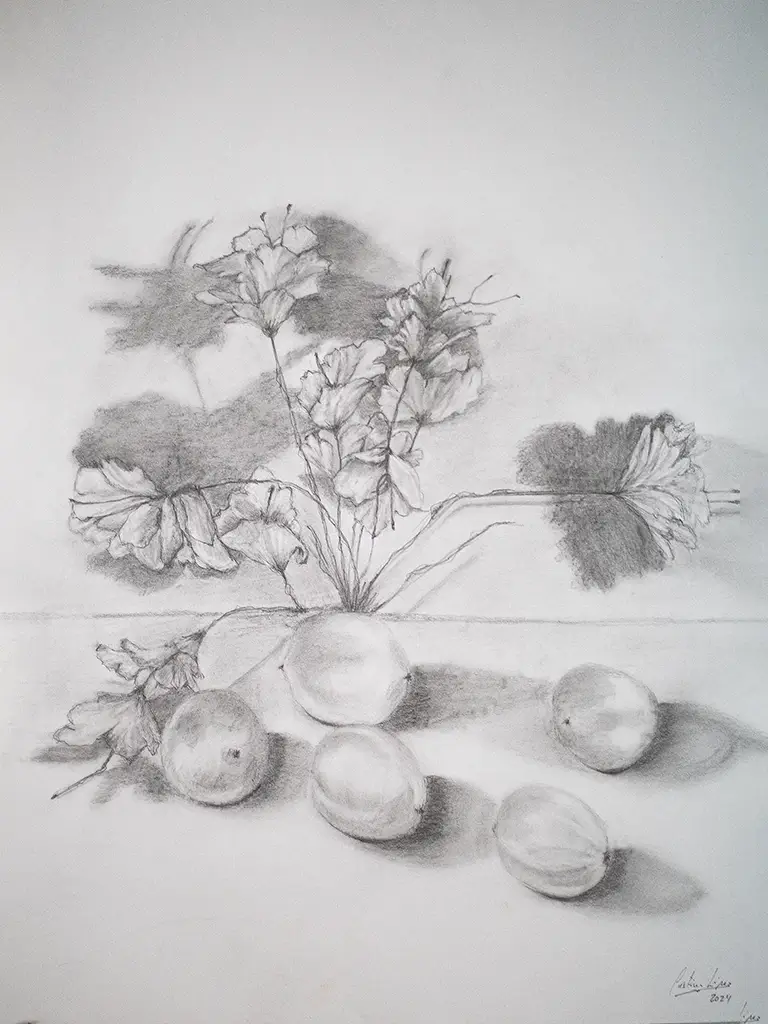
This study of lemons in charcoal captures with sober intensity the stillness and complexity of the everyday. The painting presents three lemons arranged on a rough surface, probably wood, where the texture is insinuated with dense, dark strokes. There is no colour, only shadows. The absence of vibrant yellow forces the viewer to look beyond the obvious: to observe the wrinkles in the skin, the subtle weight of each fruit, the way the light hits the outline and dissolves into the background, almost as if the lemons were emerging from a silent penumbra.
The process of creation was entirely analogue: it began with prolonged observation in natural afternoon light, in a small studio with west-facing windows. The lemons were placed unpretentiously, without any studied composition, simply as they had been left after purchase at the market. What began as a technical exercise in chiaroscuro became a graphic meditation on time and imperfection.
Inspiration was born out of a need to pause. The artist, overwhelmed by the constant rhythm of digital colour and the immediacy of modernity, sought refuge in the elemental: paper, charcoal and fruit. There is something in lemons that refers to the ephemeral – their aroma, their acidity, their ripening process – and that transience is contrasted here with the permanence of the graphite on the paper. In each stroke we perceive the intention of capturing not only a form, but a sensation: the light weight of the simple that nevertheless persists in the visual memory.